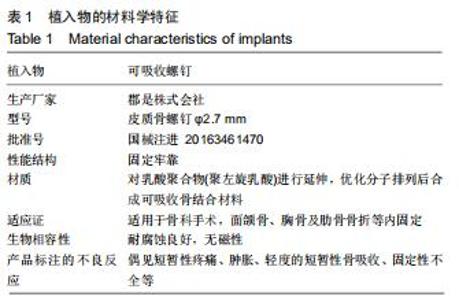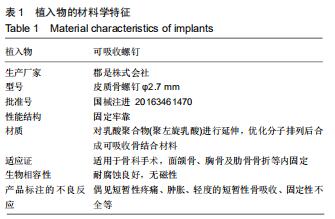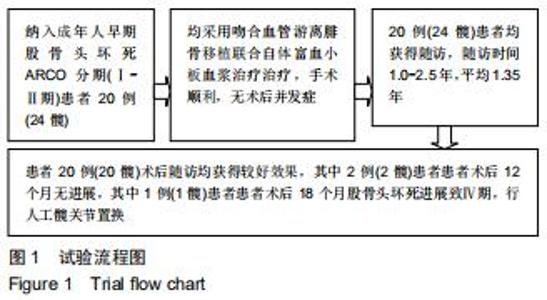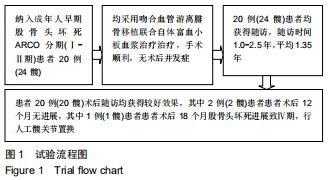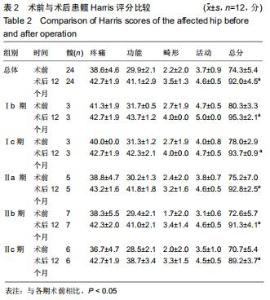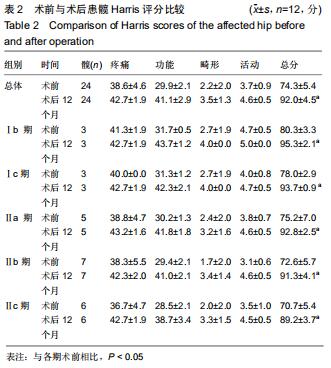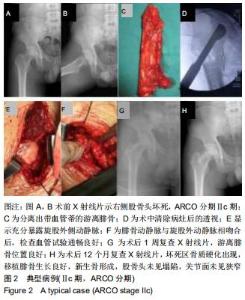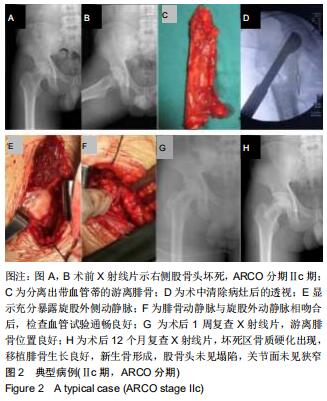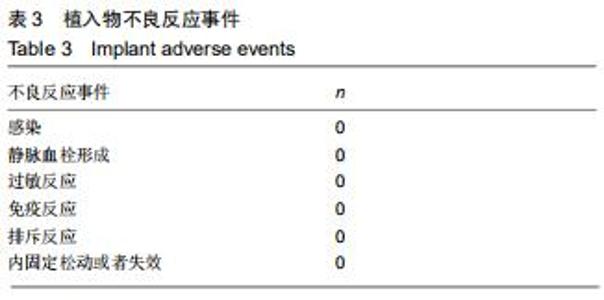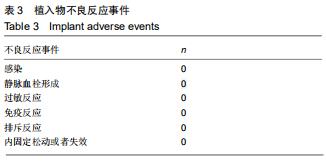Chinese Journal of Tissue Engineering Research ›› 2020, Vol. 24 ›› Issue (35): 5675-5681.doi: 10.3969/j.issn.2095-4344.2926
Previous Articles Next Articles
Efficacy of free fibula transplantation combined with platelet rich plasma in the treatment of early necrosis of the femoral head
Mo Fan1, Hua Qikai2, Zhao Jinmin2, Sha Ke2, Xie Qi1, Zhang Jin2, Yang Yuan1, Huang Weifeng1, Wang Hao3, Huang Hao1, Chen Yinghua1
1Department of Orthopaedics, Langdong Hospital of Guangxi Medical University; 2Department of Orthopaedics, the First Affiliated Hospital of Guangxi Medical University; 3Graduate School of Guangxi University of Chinese Medicine
-
Received:2020-02-25Revised:2020-03-04Accepted:2020-04-12Online:2020-12-18Published:2020-10-19 -
Contact:Zhao Jinmin, MD, Chief physician, Department of Orthopaedics, the First Affiliated Hospital of Guangxi Medical University, Nanning 530007, Guangxi Zhuang Autonomous Region, China -
About author:Mo Fan, Master, Attending physician, Department of Orthopaedics, Langdong Hospital of Guangxi Medical University, Nanning 530000, Guangxi Zhuang Autonomous Region, China -
Supported by:the Scientific Research and Technological Development Project of Guangxi Zhuang Autonomous Region, No. 1598011-5; the Research Project Funded by Health and Health Committee of Guangxi Zhuang Autonomous Region, No. Z20190753
CLC Number:
Cite this article
Mo Fan, Hua Qikai, Zhao Jinmin, Sha Ke, Xie Qi, Zhang Jin, Yang Yuan, Huang Weifeng, Wang Hao, Huang Hao, Chen Yinghua. Efficacy of free fibula transplantation combined with platelet rich plasma in the treatment of early necrosis of the femoral head[J]. Chinese Journal of Tissue Engineering Research, 2020, 24(35): 5675-5681.
share this article
|
[1] LESPASIO MJ, SODHI N, MONT MA. Osteonecrosis of the hip: a primer. Perm J. 2019;23:18-100.
[2] LIU T, MA J, SU B, et al. A 12-year follow-up study of combined treatment of post-severe acute respiratory syndrome patients with femoral head necrosis. Ther Clin Risk Manag. 2017;13:1449-1454.
[3] GUO P, GAO F, WANG Y, et al. The use of anticoagulants for prevention and treatment of osteonecrosis of the femoral head: a systematic review. Medicine (Baltimore). 2017;96(16): e6646.
[4] KANG JS, SUH YJ, MOON KH, et al. Clinical efficiency of bone marrow mesenchymal stem cell implantation for osteonecrosis of the femoral head: a matched pair control study with simple core decompression. Stem Cell Res Ther. 2018;9(1):274.
[5] 张长青.股骨头坏死保髋治疗指南(2016版)[J].中华老年骨科与康复电子志,2016,2(2):65-70.
[6] 李子荣.股骨头坏死临床诊疗规范[J].中国矫形外科杂志,2016, 24(1):49-54.
[7] 王坤正,王春生.股骨头坏死保守治疗存在的问题和思考[J].中华外科杂志,2019,57(11):801-803.
[8] 刘松,韦标方,郭霞霞,等.富血小板血浆联合髋关节外科脱位头颈开窗植骨术治疗围塌陷期股骨头坏死的临床疗效[J].医学研究生学报,2018,31(1):48-51.
[9] LARSON E, JONES LC, GOODMAN SB, et al. Early-stage osteonecrosis of the femoral head: where are we and where are we going in year 2018? Int Orthop. 2018;42(7): 1723-1728.
[10] LI J, LI ZL, ZHANG H, et al. Long-term Outcome of Multiple Small-diameter Drilling Decompression Combined with Hip Arthroscopy versus Drilling Alone for Early Avascular Necrosis of the Femoral Head. Chin Med J (Engl). 2017; 130(12):1435-1440.
[11] 周明旺,陈彦同,李盛华,等.股骨头坏死保髋治疗[J].中国骨质疏松杂志,2019,25(9):1351-1356.
[12] TU Y, CHEN Z, LINEAWEAVER WC, et al. Different recipient vessels for free microsurgical fibula flaps in the treatment of avascular necrosis of the femoral head: a systematic review and meta-analysis. Ann Plast Surg. 2017; 79(6):583-589.
[13] CAO L, GUO C, CHEN J, et al. Free vascularized fibular grafting improves vascularity compared with core decompression in femoral head osteonecrosis: a randomized clinical trial. Clin Orthop Relat Res.2017; 475(9):2230-2240.
[14] 赵德伟.规范激素的临床应用,预防及早期治疗激素性股骨头坏死[J].中华骨科杂志,2019,39(23):1421-1423.
[15] BABA T, NOZAWA M, HOMMA Y, et al. Long-term results of rotational acetabular osteotomy for osteonecrosis with collapse of the femoral head in young patients. Arch Orthop Trauma Surg. 2017;137(7):925-931.
[16] 傅维民,刘保一,王本杰,等.激素性股骨头坏死的保髋治疗策略及疗效[J].中华骨科杂志,2019,39(23):1424-1431.
[17] 张长青,侯春林,顾立强,等.青壮年股骨颈骨折的显微外科治疗专家共识[J].中华显微外科杂志,2016,39(3):209-212.
[18] LEE YK, PARK CH, HA YC, et al. Comparison of surgical parameters and results between curved varus osteotomy and rotational osteotomy for osteonecrosis of the femoral head. Clin Orthop Surg. 2017;9(2):160-168.
[19] 胡剑秋,程栋,杨胜相,等.单切口游离腓骨移植治疗II期股骨头缺血性坏死28例[J].中华显微外科杂志,2019,42(6):599-602.
[20] ANITUA E, PINO A, ORIVE G. Plasma rich in growth factors promotes dermal fibroblast proliferation, migration and biosynthetic activity. J Wound Care. 2016;25(11):680-687.
[21] 姜良斌,刘松,岳永彬,等.富血小板血浆联合钻孔减压、同种异体腓骨支撑治疗早期股骨头坏死的研究[J].中国临床解剖学杂志, 2018,36(1):93-97.
[22] 蒋冬升,张艳军,赵鹏.混合PRP的自体髂骨植入联合髓芯减压术治疗早期股骨头缺血坏死[J].山东医学高等专科学校学报,2019, 41(4):295-297.
[23] HARRIS WH. Traumatic arthritis of the hip after dislocation and acetabular fractures: treatment by mold arthroplasty. An end-result study using a new method of result evaluation. J Bone Joint Surg Am. 1969;51(4):737-755.
[24] 林春博,罗道明,蔡金宏,等.关节镜下微骨折术联合富血小板血浆治疗膝关节软骨损伤的临床效果[J].广西医学,2018,40(17): 1921-1924.
[25] 董帅,蔡喜雨,朱征威.吻合血管游离腓骨移植治疗股骨头缺血性坏死技术总结及手术器械改进[J].中国修复重建外科杂志,2017, 31(2):129-133.
[26] 中国医师协会骨科医师分会显微修复工作委员会,中国修复重建外科专业委员会骨缺损及骨坏死学组,中华医学会骨科分会显微修复学组.成人股骨头坏死临床诊疗指南(2016)[J].中华骨科杂志,2016,36(15):945-954.
[27] 张驰,吕浩源,章晓云,等.股骨头坏死不同保髋手术后髋关节功能的网状Meta分析[J].中国组织工程研究,2019,23(16): 2585-2593.
[28] PAK J, LEE JH, JEON JH, et al. Complete resolution of avascular necrosis of the human femoral head treated with adipose tissue-derived stem cells and platelet-rich plasma. J Int Med Res. 2014;42(6):1353-1362.
[29] ASSI C, KHEIR N, SAMAHA C, et al. Early results of total hip arthroplasty using dual-mobility cup in patients with osteonecrosis of the femoral head [published correction appears in SICOT J. 2018;4:37.
[30] DAILIANA ZH, STEFANOU N, KHALDI L, et al. Vascular endothelial growth factor for the treatment of femoral head osteonecrosis: an experimental study in canines. World J Orthop. 2018;9(9):120-129.
[31] LANDGRAEBER S, WARWAS S, CLAßEN T, et al. Modifications to advanced Core decompression for treatment of Avascular necrosis of the femoral head. BMC Musculoskelet Disord. 2017;18(1):479.
[32] WORSTER AA, NIXON AJ, BROWER-TOLAND BD, et al. Effect of transforming growth factor beta1 on chondrogenic differentiation of cultured equine mesenchymal stem cells. Am J Vet Res. 2000;61(9):1003-1010.
[33] 于鹏,纪志华,贾丙申,等.髓芯减压联合富血小板血浆对兔激素性股骨头坏死的疗效及对金属蛋白酶/基质金属蛋白酶组织抑制剂系统的影响[J].中国比较医学杂志,2018,28(2):53-58.
[34] 周斌,廖琦,程立明,等.富血小板血浆对股骨头坏死微环境下犬骨髓基质干细胞增殖与分化的影响[J].中华创伤骨科杂志,2013, 15(11):994-998. [35] 王哲,李炎,娄理想,等.富血小板血浆联合髓芯减压调控激素性股骨头坏死模型兔氧化应激反应[J].中国组织工程研究,2020, 24(11):1677-1682.
[36] 袁明武,罗瀚文,方怀玺,等.髓芯减压联合富血小板血浆及β-磷酸三钙陶瓷骨治疗早期股骨头坏死疗效分析[J].中国骨与关节损伤杂志,2019,34(6):596-598.
[37] 郭海,刘予豪,姜山,等.富血小板血浆应用于早期非创伤性股骨头坏死的研究进展[J].中华关节外科杂志(电子版),2017,11(6): 651-654.
[38] MARTIN JR, HOUDEK MT, SIERRA RJ. Use of concentrated bone marrow aspirate and platelet rich plasma during minimally invasive decompression of the femoral head in the treatment of osteonecrosis. Croat Med J. 2013;54(3): 219-224.
[39] GUADILLA J, FIZ N, ANDIA I, et al. Arthroscopic management and platelet-rich plasma therapy for avascular necrosis of the hip. Knee Surg Sports Traumatol Arthrosc. 2012;20(2): 393398.
[40] 唐俊,黄克,李林,等.髓芯减压植骨联合自体骨髓及富血小板血浆治疗早期股骨头缺血性坏死[J].医学理论与实践,2013,26(10): 1273-1274, 1277.
[41] MARTIN JR, HOUDEK MT, SIERRA RJ. Use of concentrated bone marrow aspirate and platelet rich plasma during minimally invasive decompression of the femoral head in the treatment of osteonecrosis. Croat Med J. 2013;54(3): 219-224.
[42] 杨富强,杨晓明,葛建健,等.髓芯减压植骨联合富血小板血浆治疗股骨头缺血性坏死的前瞻随机对照研究[J].中华关节外科杂志(电子版),2016,10(2):22-25.
[43] WEI BF, GE XH. Treatment of osteonecrosis of the femoral head with core decompression and bone grafting. Hip Int. 2011;21(2):206-210.
[44] 吴晓斌,郭静,刘朝阳,等.富血小板血浆联合同种异体骨移植治疗早期股骨头坏死[J].中国骨科临床与基础研究杂志,2017,9(4): 218-222.
[45] PAPAVASILIOU AV, TRIANTAFYLLOPOULOS I, PAXINOS O, et al. The role of cell therapies and hip arthroscopy in the management of osteonecrosis: an update. J Hip Preserv Surg. 2018;5(3):202-208.
[46] 陈山林,荣艳波,苗荷佳,等.骨科机器人辅助游离腓骨移植治疗股骨头缺血性坏死[J].中华显微外科杂志,2019,42(5):423-428.
[47] 郭晓忠,李兵,岳聚安,等.髓芯减压植骨加异体腓骨支撑治疗早期股骨头缺血性坏死的单中心长期临床疗效研究[J].中华骨与关节外科杂志,2018,11(12):904-909.
[48] JUDET H, GILBERT A. Long-term results of free vascularized fibular grafting for femoral head necrosis. Clin Orthop Relat Res. 2001;(386):114-119.
[49] BABHULKAR S. Osteonecrosis of femoral head: treatment by core decompression and vascular pedicle grafting. Indian J Orthop. 2009;43(1):27-35. [50] 刘晓琳,盛加根,张长青.单侧供体吻合血管腓骨移植治疗双侧股骨头坏死应用解剖学研究[J].国际骨科学杂志,2011,32(3): 189-191,201. |
| [1] | Hu Kai, Qiao Xiaohong, Zhang Yonghong, Wang Dong, Qin Sihe. Treatment of displaced intra-articular calcaneal fractures with cannulated screws and plates: a meta-analysis of 15 randomized controlled trials [J]. Chinese Journal of Tissue Engineering Research, 2021, 25(9): 1465-1470. |
| [2] | Huang Dengcheng, Wang Zhike, Cao Xuewei. Comparison of the short-term efficacy of extracorporeal shock wave therapy for middle-aged and elderly knee osteoarthritis: a meta-analysis [J]. Chinese Journal of Tissue Engineering Research, 2021, 25(9): 1471-1476. |
| [3] | Xu Feng, Kang Hui, Wei Tanjun, Xi Jintao. Biomechanical analysis of different fixation methods of pedicle screws for thoracolumbar fracture [J]. Chinese Journal of Tissue Engineering Research, 2021, 25(9): 1313-1317. |
| [4] | Jiang Yong, Luo Yi, Ding Yongli, Zhou Yong, Min Li, Tang Fan, Zhang Wenli, Duan Hong, Tu Chongqi. Von Mises stress on the influence of pelvic stability by precise sacral resection and clinical validation [J]. Chinese Journal of Tissue Engineering Research, 2021, 25(9): 1318-1323. |
| [5] | Zhang Tongtong, Wang Zhonghua, Wen Jie, Song Yuxin, Liu Lin. Application of three-dimensional printing model in surgical resection and reconstruction of cervical tumor [J]. Chinese Journal of Tissue Engineering Research, 2021, 25(9): 1335-1339. |
| [6] | Zhang Yu, Tian Shaoqi, Zeng Guobo, Hu Chuan. Risk factors for myocardial infarction following primary total joint arthroplasty [J]. Chinese Journal of Tissue Engineering Research, 2021, 25(9): 1340-1345. |
| [7] | Wei Wei, Li Jian, Huang Linhai, Lan Mindong, Lu Xianwei, Huang Shaodong. Factors affecting fall fear in the first movement of elderly patients after total knee or hip arthroplasty [J]. Chinese Journal of Tissue Engineering Research, 2021, 25(9): 1351-1355. |
| [8] | Wang Jinjun, Deng Zengfa, Liu Kang, He Zhiyong, Yu Xinping, Liang Jianji, Li Chen, Guo Zhouyang. Hemostatic effect and safety of intravenous drip of tranexamic acid combined with topical application of cocktail containing tranexamic acid in total knee arthroplasty [J]. Chinese Journal of Tissue Engineering Research, 2021, 25(9): 1356-1361. |
| [9] | Xiao Guoqing, Liu Xuanze, Yan Yuhao, Zhong Xihong. Influencing factors of knee flexion limitation after total knee arthroplasty with posterior stabilized prostheses [J]. Chinese Journal of Tissue Engineering Research, 2021, 25(9): 1362-1367. |
| [10] | Huang Zexiao, Yang Mei, Lin Shiwei, He Heyu. Correlation between the level of serum n-3 polyunsaturated fatty acids and quadriceps weakness in the early stage after total knee arthroplasty [J]. Chinese Journal of Tissue Engineering Research, 2021, 25(9): 1375-1380. |
| [11] | Zhang Chong, Liu Zhiang, Yao Shuaihui, Gao Junsheng, Jiang Yan, Zhang Lu. Safety and effectiveness of topical application of tranexamic acid to reduce drainage of elderly femoral neck fractures after total hip arthroplasty [J]. Chinese Journal of Tissue Engineering Research, 2021, 25(9): 1381-1386. |
| [12] | Wang Haiying, Lü Bing, Li Hui, Wang Shunyi. Posterior lumbar interbody fusion for degenerative lumbar spondylolisthesis: prediction of functional prognosis of patients based on spinopelvic parameters [J]. Chinese Journal of Tissue Engineering Research, 2021, 25(9): 1393-1397. |
| [13] | Lü Zhen, Bai Jinzhu. A prospective study on the application of staged lumbar motion chain rehabilitation based on McKenzie’s technique after lumbar percutaneous transforaminal endoscopic discectomy [J]. Chinese Journal of Tissue Engineering Research, 2021, 25(9): 1398-1403. |
| [14] | Chen Xinmin, Li Wenbiao, Xiong Kaikai, Xiong Xiaoyan, Zheng Liqin, Li Musheng, Zheng Yongze, Lin Ziling. Type A3.3 femoral intertrochanteric fracture with augmented proximal femoral nail anti-rotation in the elderly: finite element analysis of the optimal amount of bone cement [J]. Chinese Journal of Tissue Engineering Research, 2021, 25(9): 1404-1409. |
| [15] | Du Xiupeng, Yang Zhaohui. Effect of degree of initial deformity of impacted femoral neck fractures under 65 years of age on femoral neck shortening [J]. Chinese Journal of Tissue Engineering Research, 2021, 25(9): 1410-1416. |
| Viewed | ||||||
|
Full text |
|
|||||
|
Abstract |
|
|||||
